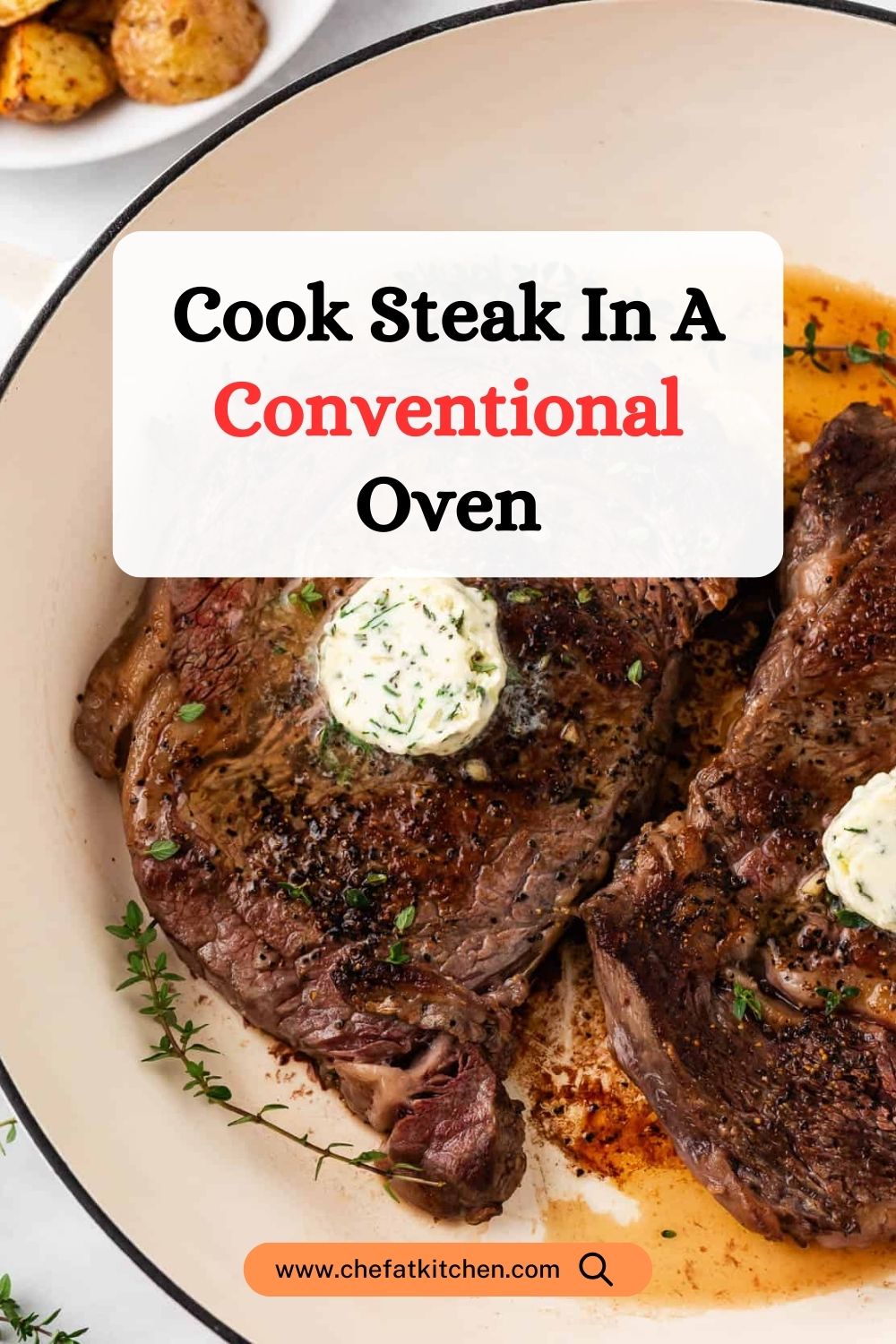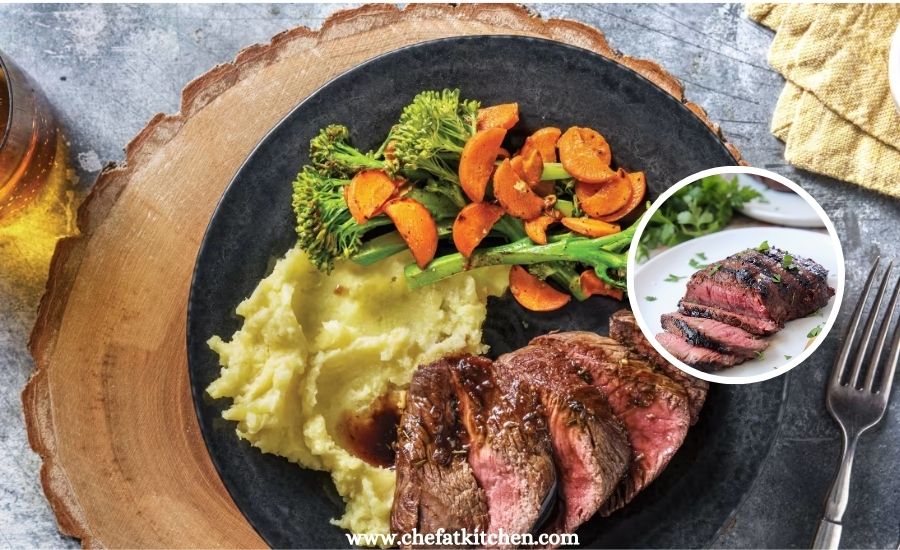Every product is independently reviewed and selected by our editors. If you buy something through our links, we may earn an affiliate commission at no extra cost to you.
There’s something undeniably satisfying about a perfectly cooked steak—juicy, flavorful, and seared to perfection.
While grilling is a popular method for cooking steak, not everyone has access to a grill.
The good news is that you can achieve restaurant-quality results right in your kitchen using a conventional oven.
In this guide, we’ll walk you through the step-by-step process of cooking a mouthwatering steak without the need for a grill.
How To Select The Right Cut Of Steak

When it comes to cooking the perfect steak in a conventional oven, selecting the right cut of meat is crucial.
The choice of steak cut can greatly impact the taste, tenderness, and overall cooking experience.
To help you make an informed decision, let’s explore two essential factors: choosing the steak cut and the importance of steak thickness.
Choosing The Steak Cut
To selecting the perfect cut of beef for your oven-cooked steak, you have a range of options to consider.
Here are some popular choices:
| Steak Cut | Description |
|---|---|
| Ribeye | Known for its rich marbling and exceptional flavor, the ribeye is a popular choice among steak enthusiasts. |
| New York Strip | Featuring a fine balance of tenderness and flavor, the New York Strip steak is a classic option. |
| Tenderloin/Filet Mignon | Renowned for its sublime tenderness and melt-in-your-mouth texture, the tenderloin or filet mignon is a top choice for special occasions. |
Importance Of Steak Thickness
Aside from the steak cut, the thickness of the steak plays a vital role in achieving the desired doneness and overall taste.
The thickness you choose can determine how quickly the steak cooks and how well it retains its juiciness and flavor.
Here are some key points to consider:
- A thicker steak, such as one inch or more, will result in a juicier and more tender piece of meat.
- Thinner steaks, around half an inch or less, cook faster but are more prone to overcooking.
- For medium-rare to medium doneness, a 1.5-inch steak is recommended for optimal results.
By selecting the right cut of steak and considering the thickness, you can elevate your oven-cooked steak to a whole new level.
Keep in mind that personal preference and cooking expertise also play a role in determining the perfect steak for your taste buds.
Experiment with different cuts and thicknesses to find your culinary sweet spot.
How To Prepare The Steak
To cook steak in a conventional oven, season the steak and let it reach room temperature.
Then, bake it in a low-temperature oven until it reaches your desired internal temperature.
Let it rest for ten minutes before serving.
Seasoning The Steak
Once you have your steak ready, it’s time to add some flavor with the right seasoning.
Generously sprinkle both sides of the steak with kosher salt and freshly cracked black pepper or any other seasoning of your choice.
Remember to season it well as the flavors will develop when the steak is cooked.
Allowing The Steak To Reach Room Temperature
After seasoning the steak, it’s crucial to allow it to come to room temperature before cooking.
This process ensures that the steak cooks evenly and results in a juicy and tender outcome.
Simply place the steak on a plate and let it sit for about 30 minutes. This will help the steak to cook more evenly.
Now that you’ve seasoned the steak and allowed it to come to room temperature, you’re ready to start cooking in the conventional oven.
How To Preheat The Conventional Oven
Before you start cooking your steak in a conventional oven, it is crucial to preheat the oven to ensure even cooking.
Setting The Oven Temperature
Turn on your oven and set it to the desired temperature. For steak, a high temperature between 400°F to 450°F is ideal for a quick sear.
Placing The Oven Rack
Position the oven rack in the center of the oven to allow the heat to circulate evenly around the steak.
How To Cook The Steak
Cooking the perfect steak in a conventional oven is easier than you think.
Just season the steak, let it come to room temperature, and then bake it in a low-temperature oven until it reaches your desired internal temperature.
Let it rest for a few minutes before serving for the best results.
Searing The Steak
Searing the steak is a crucial step to lock in juices. Pat the steak dry with paper towels, then season generously with salt and pepper.
Heat a cast-iron skillet over high heat. Add oil and let it heat until it shimmers.
Gently place the steak in the pan and cook until a crust forms, about 2 minutes per side.
Finishing The Steak In The Conventional Oven
Finishing the steak in the oven allows for even cooking. Preheat the oven to the desired temperature based on your steak’s doneness preference.
Transfer the seared steak to a baking dish or a wire rack set on a baking sheet. Place it in the oven and cook until it reaches the desired internal temperature.
Resting And Serving
After cooking the steak to perfection in the conventional oven, it’s crucial to adhere to proper resting and serving techniques.
This essential step ensures that the flavors and juiciness are retained, resulting in a delectable dining experience.
Resting The Steak
Resting the steak after cooking is vital to allow the juices to redistribute within the meat. Once the steak is out of the oven, transfer it to a cutting board or plate.
Cover it loosely with foil to keep it warm and let it rest for at least 10 minutes.
This resting period allows the steak to reabsorb its juices, leading to a tender and succulent texture.
Slicing And Serving The Steak
Slicing and serving the steak should be done in a manner that preserves its juices and enhances the overall dining experience.
Using a sharp knife, slice the steak across the grain into thin strips to ensure tenderness.
Arrange the slices on a serving platter and garnish with fresh herbs for a visually appealing presentation.
Should I marinate the steak before cooking it in a conventional oven?
Marinating steak before cooking it in a conventional oven is a matter of personal preference and depends on the desired outcome in terms of flavor and tenderness.
Here are some considerations to help you decide:
Benefits of Marinating:
- Flavor Enhancement: Marinating can infuse the steak with deeper or additional flavors, depending on the ingredients used in the marinade. Ingredients like herbs, spices, and aromatics contribute to the overall taste profile of the cooked steak.
- Tenderness: Certain ingredients in marinades, such as acidic components (vinegar, lemon juice, wine) or enzymes found in fruits like pineapple, kiwi, and papaya, can help break down some of the muscle fibers, potentially resulting in a more tender steak.
- Moisture Retention: A marinade can help the surface of the steak retain moisture during the cooking process, potentially leading to a juicier final product.
Considerations:
- Cut of Steak: Leaner cuts like sirloin or filet mignon may benefit more from marinating than fattier cuts like ribeye, which are already tender and flavorful due to their fat content.
- Marinating Time: The ideal marinating time can vary depending on the type of steak and the components of the marinade. Too long in an acidic marinade can start to “cook” the surface of the steak or make it mushy, so generally, a few hours to overnight is sufficient.
- Cooking Technique Adjustments: If you choose to marinate your steak, pat it dry before searing it in a hot pan. Excess marinade on the surface of the steak can cause it to steam rather than sear, potentially impacting the texture and flavor of the crust.
How Long To Cook Steak In Conventional Oven At 400?
Cook steak in the oven at 400°F for about 20 minutes for medium-rare to medium doneness.
What Temp Should I Cook Steak In The Conventional Oven?
Cook steak in the oven at 400°F for medium-rare, or 425°F for medium.
How Long To Cook Steak In Conventional Oven At 350?
Cook steak in oven at 350°F for about 15-20 minutes for medium-rare doneness. Adjust time based on desired doneness.
Do You Cook Steak In The Conventional Oven Covered Or Uncovered?
Cook steak in the oven uncovered for an even roast and perfect sear.
Conclusion
Cooking the perfect steak in a conventional oven is a skill worth mastering.
With the right techniques and attention to detail, you can achieve a steak that rivals those served in top-notch steakhouses.
Experiment with seasoning and cooking times to find your perfect balance and treat yourself to a restaurant-quality steak without ever firing up the grill. Happy cooking!

